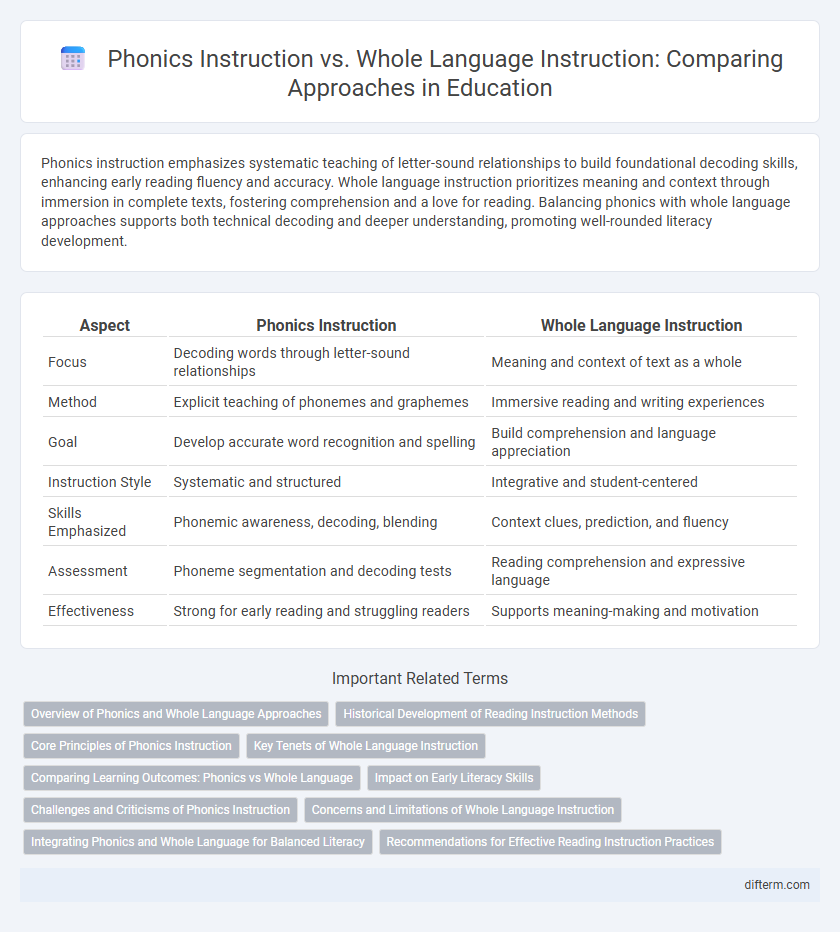Phonics instruction emphasizes systematic teaching of letter-sound relationships to build foundational decoding skills, enhancing early reading fluency and accuracy. Whole language instruction prioritizes meaning and context through immersion in complete texts, fostering comprehension and a love for reading. Balancing phonics with whole language approaches supports both technical decoding and deeper understanding, promoting well-rounded literacy development.
Table of Comparison
| Aspect | Phonics Instruction | Whole Language Instruction |
|---|---|---|
| Focus | Decoding words through letter-sound relationships | Meaning and context of text as a whole |
| Method | Explicit teaching of phonemes and graphemes | Immersive reading and writing experiences |
| Goal | Develop accurate word recognition and spelling | Build comprehension and language appreciation |
| Instruction Style | Systematic and structured | Integrative and student-centered |
| Skills Emphasized | Phonemic awareness, decoding, blending | Context clues, prediction, and fluency |
| Assessment | Phoneme segmentation and decoding tests | Reading comprehension and expressive language |
| Effectiveness | Strong for early reading and struggling readers | Supports meaning-making and motivation |
Overview of Phonics and Whole Language Approaches
Phonics instruction systematically teaches the relationship between letters and sounds, enabling children to decode words by sounding them out, which supports early reading development and literacy skills. Whole language instruction emphasizes meaning and context, encouraging students to recognize words as whole pieces and focus on comprehension and language experience rather than isolated phonetic rules. Research indicates that integrating phonics within a whole language framework can enhance reading proficiency by combining decoding skills with contextual understanding.
Historical Development of Reading Instruction Methods
Phonics instruction, rooted in explicit teaching of letter-sound relationships, gained prominence in the early 20th century as a systematic approach to decoding words, contrasting with the whole language method that emerged in the 1980s, emphasizing context and meaning through immersion in authentic texts. The debate between these methods shaped educational policies and literacy curricula, with research highlighting phonics' effectiveness in early reading acquisition and whole language's role in fostering comprehension and motivation. Historical shifts reflect evolving understandings of cognitive processes in reading and the need for balanced literacy approaches integrating both phonics and whole language principles.
Core Principles of Phonics Instruction
Phonics instruction emphasizes systematic teaching of letter-sound relationships, enabling students to decode words by blending sounds. Core principles include explicit instruction, sequential progression from simple to complex phonemes, and continuous practice for automatic word recognition. This approach contrasts with whole language instruction by prioritizing foundational decoding skills essential for early literacy development.
Key Tenets of Whole Language Instruction
Whole language instruction emphasizes learning words and language in context, prioritizing meaning and comprehension over isolated phonetic decoding. It encourages natural language acquisition through exposure to rich, authentic texts and promotes reading strategies such as prediction and inference. This approach fosters holistic literacy development by integrating speaking, listening, reading, and writing skills in meaningful communication.
Comparing Learning Outcomes: Phonics vs Whole Language
Phonics instruction typically yields stronger decoding skills and improved reading accuracy by focusing on letter-sound relationships, which enhances early literacy development. Whole language instruction emphasizes comprehension and meaning, promoting fluency and engagement, but may result in slower word recognition progress. Studies reveal phonics-based methods often lead to higher standardized reading achievement scores, while whole language fosters better contextual understanding and vocabulary growth.
Impact on Early Literacy Skills
Phonics instruction significantly enhances early literacy skills by systematically teaching the relationship between letters and sounds, enabling children to decode words efficiently. Whole language instruction emphasizes context and meaning, promoting a holistic understanding of text but often delays explicit phonics learning. Research shows that combining phonics with whole language strategies results in stronger reading fluency and comprehension among early learners.
Challenges and Criticisms of Phonics Instruction
Phonics instruction faces criticism for its rigid emphasis on letter-sound relationships, often neglecting contextual comprehension and making it challenging for students with diverse learning styles or language backgrounds to engage effectively. This method can struggle to address irregular English spelling patterns, potentially leading to student frustration or disengagement. Educators also highlight the difficulty in balancing phonics with broader literacy skills, which may hinder developing critical reading comprehension and vocabulary depth.
Concerns and Limitations of Whole Language Instruction
Whole language instruction faces criticism for its lack of explicit phonics teaching, which can hinder early decoding skills essential for reading proficiency. Research indicates that this approach may lead to difficulties in recognizing unfamiliar words and slower development of foundational literacy skills. Educators express concern that without systematic phonics, students at risk for reading disabilities might not receive the structured support needed for effective literacy acquisition.
Integrating Phonics and Whole Language for Balanced Literacy
Integrating phonics instruction with whole language approaches fosters balanced literacy by combining systematic decoding skills with contextual language comprehension. This method enhances reading fluency and promotes meaningful engagement with texts, supporting both word recognition and vocabulary development. Research shows that balanced literacy programs improve overall reading proficiency by addressing diverse learner needs through a comprehensive, multifaceted approach.
Recommendations for Effective Reading Instruction Practices
Phonics instruction emphasizes systematic teaching of letter-sound relationships, enhancing decoding skills essential for early reading fluency. Whole language instruction promotes context-based learning and comprehension through exposure to meaningful text, fostering a love for reading. Effective reading instruction integrates phonics with rich, authentic reading experiences, tailoring practices to individual student needs for balanced literacy development.
Phonics instruction vs Whole language instruction Infographic

 difterm.com
difterm.com